|
 |
 |
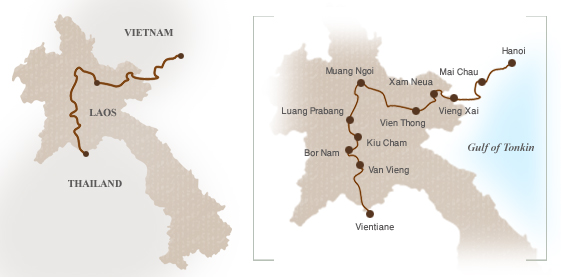 |
 |
Tour Details
HANOI TO VIENTIANE
Road Bicycling with Support
12 Days/ 12 Nights
Intermediate Cycling
90% Good Condition Paved Roads
Arrival: Hanoi, Vietnam
Depart: Vientiane, Laos
Extension: Halong Bay Kayaking
Extension: Temples of Angkor |
 |
Tour Dates:
April 18 to May 3, 2010 or custom
December 21 to Jan 2, 2010/11
|

| |
| |
|
|
 |
|
|
"Luang Prabang is a little city of about 100,000 people that neither teems with excitement nor seethes with intrigue. Life flows slowly here, like the muddy Mekong. The people are gentle and unassuming. Two lazy rivers happen upon each other in their wanderings through Luang Prabang -- the Nam Khan and the swirling brown Mekong. Traditional Lao houses, high on teak pilings, creep down to the river's edge, engulfed in tall swaying palms and jungle shrubs. Children laugh and play here, jumping from high trees into the rich brown river -- bathtub of millions. A few small pirogues drift downstream, carrying fruits or hauling nets. A person could stay here forever and not even realize it." ~Ben
What were the rural roads in northern Thailand like twenty years ago? Vietnam ten years back? They were much like the roads on this trip through northern Laos. On a recent trip our group spent a couple of hours at the new Vietnamese immigration post, then exiting Vietnam and processing our visas on the Laos side of the border. During this time, nobody passed through the border area. That's how empty these roads are.
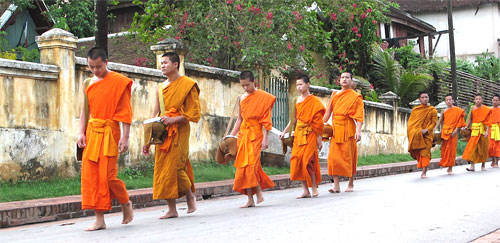
Come ride through picturesque karst scenery, punctuated by jungle laden national parks and rural villages in Southeast Asia's least populated countries. New roads make for a comfortable ride and newer guest houses are far from roughing it. Meals are served up with all the usual favorites, including spring rolls, noodle soup and curries. Another pleasant surprise is the tall, cold Beer Lao gets the nod over Angkor beer and Vietnam's selections of brews, who'd have figured? In ten years, you'll be able to say you went there when it was like this.
 A note on mileage. With multiple vehicles, our custom tours provide for any amount of cycling your group, or even particular people in your group, want to ride (or not ride). Mileage below is only a suggestion, shorter (and much longer) distances can be arranged, even during each day's ride, and off-bike activities planned to fill the time. A note on mileage. With multiple vehicles, our custom tours provide for any amount of cycling your group, or even particular people in your group, want to ride (or not ride). Mileage below is only a suggestion, shorter (and much longer) distances can be arranged, even during each day's ride, and off-bike activities planned to fill the time.
|
|
| |
|
|
|
|
 |
Day 1
|
 |
Arrive Hanoi, Vietnam
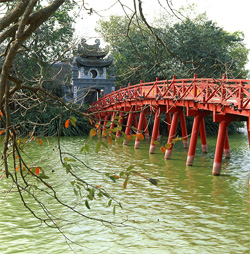 Hoan Kiem Lake
Hoan Kiem Lake
|
Arrive Hanoi's war-era Noi Bai Airport. After clearing immigration and customs meet driver and escort for transfer into Hanoi, the cultural and political capital of Vietnam that has slumbered largely unchanged for decades. After transfer to hotel on central Hoan Kiem Lake, midday
meeting at hotel for lunch orientation at an outdoor cafe for introductions, followed by bike assembly, testing and other preparations for beginning of the trip. Afterwards, free time in the capital before we rendezvous at our hotel and stroll for dinner of local specialties such as pho in the busy Old Quarter. (B,L,D)
Note: Vietnam visa required in advance of arrival (application sent with pre-tour packet)
 Pickup by private car at Noi Bai Airport, Hanoi Pickup by private car at Noi Bai Airport, Hanoi
 Hong Ngoc Hotel Hong Ngoc Hotel
 Vietnam Dining Guide (pdf) Vietnam Dining Guide (pdf)
 Bia Hoi, or happy hour, is a post-work custom unique to Hanoi, with draft beer and snacks served up in street cafes. Other culinary treats? The best pho in the country is from Hanoi, don't miss a piping hot bowl (as your guide for the better places). Bia Hoi, or happy hour, is a post-work custom unique to Hanoi, with draft beer and snacks served up in street cafes. Other culinary treats? The best pho in the country is from Hanoi, don't miss a piping hot bowl (as your guide for the better places).
|
 |
| |
|
|
|
|
 |
Day 2
|
 |
Hanoi to Mai Chau
In the morning, early departure for Mai Chau, a picturesque river valley region populated with a diversity of hilltribes. After a 2.5- 3 hour drive, arrive Mai Chau for late lunch. Balance of afternoon leisurely, warm-up cycling in and around Mai Chau to hilltribe villages, farms and scenic back roads of the area. In the afternoon, we'll cool off in the swimming pool before strolling through a nearby White Thai hilltribe village, perhaps spying a local futbol match, before visiting a private home for a traditional dance performance and dinner in the village. Overnight in Mai Chau, our last night of comfort before the moving on into the hinterland of Laos. (B,L,D)
 ~40 km ~40 km
 Mai Chau Lodge, Mai Chau Mai Chau Lodge, Mai Chau
|
 |
| |
|
|
|
|
 |
Day 3
|
 |
Mai Chau to Vieng Xai
This morning, we make a run for the border by bus on National Highway 15 through Pu Luong and and Pu Ha Nature preserves to beat the 11:00AM border closing (about 70 miles). After crossing into Laos, obtaining visas and meeting up with crew, begin riding on national route 217 , cycling uphill towards Vieng Xai on paved roads under some of the most picturesque karst scenery in Laos, passing hilltribe villages in the area, including Thai Dam, Thai Dang, Meuy, and Kmu. Picnic lunch en route.
After lunch, continued riding to Vieng Xai. After arrival, freshen up before driving outside of the town to explore a nearby network of hundreds of caves. The caves, both natural and artificial, were developed and used by Pathet Lao in Vieng Xai during the Vietnam war, including Khayson Cave, the office and residence of the Pathet Lao chief during the war period, and Souphanouvong Cave, also called Red Prince Cave, the residence of royal Prince Souphanouvong at one time. Then, onto Nouhak Cave, named for Nouhak Phoumsavang, who served as Lao PDR president from 1992.
Note: One passport-sized photo and US$35 cash required for Laos visa.
 53 km (31 miles) Laos border to Vieng Xai Caves 53 km (31 miles) Laos border to Vieng Xai Caves
 Simple Guesthouse in Vieng Xai Simple Guesthouse in Vieng Xai
|
 |
| |
|
|
|
|
 |
Day 4
|
 |
Vieng Xai to Vieng Sang
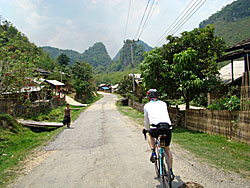 Nearing Vieng Xai
Nearing Vieng Xai |
After sunrise breakfast, departing for an epic day's journey over the "Laotian Alps" to Vieng Thong, cycling over the massive 4,000+ foot Phou Lao and Phou Leuy mountain passes, where we'll spy the 2,062 meter peak of Phou Leuy and 2,079 meter Phou Pan-Cnai in the distance.
From Vieng Xai, we continue riding on national highway 6 to Nam Noen (64.5 miles and about 4,500 feet) of climbing. En route, pausing to explore Hing Tang (Suan Hin), a man-made formation of vertical stones that may be related to those on the Plain of Jars. At Nam Noen, we'll turn northwest (right) on route 1 towards Vien Thong, a hilly 36 miles way. After arrival in Vien Thong, walking to nearby hot springs to soak worn legs before exploring the small town set on the Nam Khan River and largely inhabited by a collection of hill tribes particularly Hmong and "lowland" Lao. Before dinner, we'll stroll to neaby hot springs to soak our legs. Overnight at simple guesthouse.
 76 km (45 miles) 76 km (45 miles)
 Simple Guesthouse Simple Guesthouse
|
 |
| |
|
|
|
|
 |
Day 5
|
 |
Vien Thong to Nong Muang
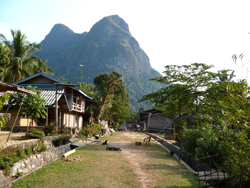 Nong Khiaw
Nong Khiaw
|
Our longest, most difficult day. Another early sunrise departure after breakfast (optional, but recommended van shuttle to ay least top of the first climb). National route No 1c between Vieng Thong and Nong Khiaw passes through beautiful scenery with lush green mountains, even in the drier season when we are passing through.
After departing Vien Thong, cycling on flats until reaching our first challenge, a 2,400 foot climb, before descending to a winding river valley road for about 12 miles until we reach our next climb of about 2,100 feet, plummeting down to Vieng Kham at mile 86 (at 1,200 feet elevation). After a third climb of 900 feet, the rest of the day is over the undulating hills on a paved, good-condition side road heading northwest to Nong Muang, a picturesque northern outpost being discovered by backpackers. (B,L,D)
 70 km (42 miles) 70 km (42 miles)
 Nam Ou Bungalows (Riverview). Nam Ou Bungalows (Riverview).
 Nong Khiaw, it doesn't get much better than this anywhere Asia. Nestled between high stone peaks covered with lush green vegetation along a tranqil river, this small town is only recently being discovered. After cold beer Laos, curry and noodle dishes, our tired legs will be treated to traditional Lao massage. Nong Khiaw, it doesn't get much better than this anywhere Asia. Nestled between high stone peaks covered with lush green vegetation along a tranqil river, this small town is only recently being discovered. After cold beer Laos, curry and noodle dishes, our tired legs will be treated to traditional Lao massage.
|
 |
| |
|
|
|
|
 |
Day 6
|
 |
Nong Khiaw excursion around Muang Ngoi
After breakfast, board longtail boat for one-hour cruise on the picturesque Nam Ou river, between jungled-covered karst peaks to Muang Ngoi. After arrival, refreshments before we begin our hike to several of the outlying, remote villages in the area.
Muang Ngoi was controlled by the communist before 1975 and the province was under control of Pathet Lao. During Vietnam War, people in this area hid in the caves in the day times and worked at night because of continuous bombing. Light trekking to Tham Kang, where, according to local legend, a sacred Naga resides.
Also pausing at the villages of Ban Na and Thai Daeng before returning back to Nong Muang by boat in the afternoon for dinner and accommodation. (B,L,D) |
 |
| |
|
|
|
|
 |
Day 7
|
 |
Nong Khiaw to Luang Prabang
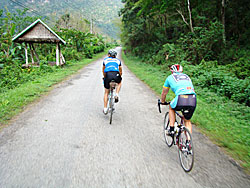 Leaving Nong Khiaw
Leaving Nong Khiaw |
From Nong Khiaw to Luang Prabang is 140 kilometers and we'll ride from breakfast through some of the prettiest and flattest parts. After turning onto the main road to Luang Prabang, the road begins to roll and some may want to pack it in not long afterwards. Slacker option: roughly a 6-hour cruise to Luang Prabang by long tail boat. This section of river is very scenic as there are jagged limestone peaks lining either side of the river. Once we reach the Mekong River we would make a slight upstream detour to visit the amazing Pak Ou caves. This open cave is locate beside the river, is packed with hundreds of Buddha images and is an important place of worship for locals. If you choose to go by boat we can arrange it on the spot and the boat fee will be split amongst the passengers.
Another
option (the third if you are counting), combines the two, riding 54 miles to where the road meets the Mekong River. From here a boat can be arranged to take us to the Pak Ou cave and then downstream to Luang Prabang. In the late afternoon we arrive Luang Prabang, one of Asia's gems and a UNESCO World Heritage. It is pleasantly located at the confluence of the Mekong and Nam Khan Rivers and encircled by distance jagged peaks. In recent years it has been a popular, but not spoiled tourist destination, but it will be a bit of a shock to see so many tourists for the first time since Hanoi. Dinner together in town. (B,L,D)
 0, 90, or 140 km (54 or 85 miles) 0, 90, or 140 km (54 or 85 miles)
 Salaprabang Boutique hotel (city center) Salaprabang Boutique hotel (city center)
|
 |
| |
|
|
|
|
 |
Day 8
|
 |
Luang Prabang
After breakfast, day free or optional cycling outside of the city to passing through several villages and pausing to visit a local family and school as well as cottage industries in the area. Aftwrwards, return to town in time for lunch.
Afternoon relaxing on the riverfront before sunset cruise on the Mekong, enjoying drinks on board. (B) |
 |
| |
|
|
|
|
| |
Day 9 |
|
Luang Prabang
Rise at dawn to view the traditional alms procession by monks moving slowly through town. After, return to hotel for breakfast and then transfer by tuk-tuk to explore Luang Prabang's local Phuosi Market before beginning exploration of the town on foot. Pause to explore major temples dating to the 15th century such as Wat Xieng Thong — a masterpiece of Buddhist architecture — followed by the Royal Palaces and museum, and other French-colonial period buildings.
At dusk, climbing to the top of Mount Phuosi for sunset before strolling through the extensive night market. (B,L)
 Luang Prabang's night market is one of the best in Indochina for finding unique, handmade goods and at a bargain rate. The market makes a good stop after watching sunset from Mount Phousi. How much to bargain? Typically, counter with offer that is about 1/3 from the price quoted. Want to see where the locals shop, take a tuk-tuk out to Phuosi Market, about 1 kilometer from the central area. Luang Prabang's night market is one of the best in Indochina for finding unique, handmade goods and at a bargain rate. The market makes a good stop after watching sunset from Mount Phousi. How much to bargain? Typically, counter with offer that is about 1/3 from the price quoted. Want to see where the locals shop, take a tuk-tuk out to Phuosi Market, about 1 kilometer from the central area.
|
|
| |
|
|
|
|
| |
Day 10 |
|
Luang Prabang to Kiu Cham, Kiu Cham to Bor Thang
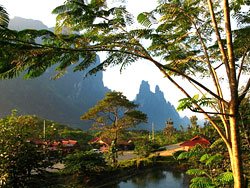 Bor Thang views
Bor Thang views
|
After early breakfast, if you wish to avoid about 18 miles of climbing, depart Luang Prabang by van, shuttling to the summit town of Kiu Cham (48 miles, about two hours) to begin our ride. Our ride this day involves more beautiful mountain scenery with longer rollers up and down, although staying at an attitude of about 4,000 feet. In the afternoon, a 15-mile downhill ride, losing about 2,500 feet, the road surrounded by peaks and cliffs before the short, steep mile and half climb to Bor Nam. A day's ride from Van Vieng, Bor Thang is nothing more than a dusty town known for its small hot spring, a tiny guest house (ours) and a trucker's restaurant (our featured dining). The bungalows are very simple, but clean with hot water provided by the hot spring. The spring warm not hot, but it's definitely worth going for a dip to loosen up those leg muscles. Next to the hot spring is a good restaurant with simple tasty food and a gorgeous views of the mountains. (B,L,D)
 74 km (46 miles) from Kiu Cham 74 km (46 miles) from Kiu Cham
 Simple Guesthouse Simple Guesthouse |
|
| |
|
|
|
|
| |
Day 11 |
|
Bor Thang to Vang Vieng
 Van Vieng
Van Vieng
|
Depart early again, not to cover a long distance, but so we have the afternoon to enjoy Vang Vieng. Early on, more downhill ride to the valley floor and after 21 kms, to the town of Kasi. From here to Vang Vieng is pretty easy riding with one small climb. For the those interested, we can tube down the tranquil Nam Song River in the afternoon with a cold drink in hand watching the rick cliff scenery go by. There are a few easy rapids and the river is suitable for beginners. Our hotel is set beside the Nam Song River with a long row of beautiful karst peaks as a the back drop. Drinks all around to celebrate this last day in the saddle! Dinner free to sample the local fare. (B,L)
 Distance: 78 km (47 miles) Distance: 78 km (47 miles)
 Elephant Crossing Hotel Elephant Crossing Hotel
|
|
| |
|
|
|
|
| |
Day 12 |
|
Van Vieng to Vientiane
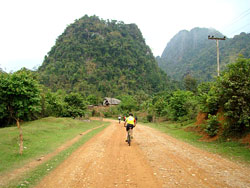 Van Vieng MTB
Van Vieng MTB
|
After breakfast, cycling for a couple of hours on the empty dirt road into the valleys around Van Vieng, pausing to swim in the blue lagoons and explore one of the larger caves. Afterwards, return to town for lunch before we transfer to the capital by van (distance: ~200 km, about 3.5 hours by van). If we reach Vientiane earlier, we can canvas almost all sites of importance in the small, sleepy capital such as the Emerald Buddha Temple, That Luang Stupa (the national symbol of Laos) and the market area before farewell with crew. In the evening, farewell dinner and live traditional music performance at a place popular with locals. (B,L,D)
 Sengtawan Hotel Sengtawan Hotel |
|
| |
|
|
|
|
| |
Day X |
|
Vientiane to Phnom Penh, Phnom Penh to Siem Reap (Optional extension to Phnom Penh and Angkor)
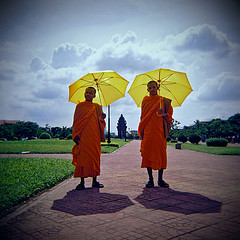 Phnom Penh Riverfront
Phnom Penh Riverfront
|
After breakfast farewells, transfer to airport for flight home or two-hour flight to Phnom Penh for our optional Cambodia extension.
After arrival in Phnom Penh, lunch along the river at the Foreign Correspondent's Club before sightseeing in town, including visit to the highly regarded National Museum exhibiting rare relics and statuary from Angkor. Afterwards, return to airport for one-hour flight to Siem Reap, base for exploring the temples of Angkor. After arrival, meet escort and transfer to hotel for late afternoon and evening strolling in town. (B,L,D)
Note: Cambodia visa issued on arrival with one photo and US$25.
 Vietnam Airlines Vientiane to Phnom Penh Vietnam Airlines Vientiane to Phnom Penh
 Divining Angkor, National Geographic Magazine June, 2009 Divining Angkor, National Geographic Magazine June, 2009 |
|
| |
|
|
|
|
 |
Day 1
|
 |
Siem Reap (Angkor)
Angkor is astounding and complex in scope. Early French explorers could not imagine the Khmer kings were responsible for such monumental work. The inspiration for Angkor architecture was born from a unique mix of Hinduism and Buddhism which drove Khmer monument construction for nearly three hundred years from the 9th to 12th centuries creating Angkorean structures that have no parallel.
In the afternoon, visit the immense walled city Angkor Thom that was the masterpiece of King Jayavarman VII. Following the occupation of Angkor by the Chams from 1177 to 1181, the new king dictated the building of an impregnable fortress at the heart of his empire and the scale of their work is staggering, immediately overwhelming visitors upon arrival at the city’s gates. The causeway is lined by an intricate bridge depicting the Churning of the Ocean of Milk from Hindu mythology in which the devas (gods) and asuras (devils) play tug of war with a naga (seven-headed serpent) to “milk” the elixir of immortality. Afterward, visit to the Bayon Temple, a "temple mountain" situated in the center of the city of Angkor Thom. A three-tiered pyramid with a central shrine surrounded by dozens of towers all crowned by gigantic faces that represent the god Avalokite-shvara. Unlike his predecessors, worshipper of Hindu deities, king Jayavarman VII adopted Mahayana Buddhism as the fount of royal divinity and this sets The Bayon apart from many other Angkorean monuments with Hindu influences.
After, visit at the Terrace of the Leper King. This intricately carved platform was the royal crematorium and the statue that was originally thought to be the leper king is now believed to be Yama, the god of death. Continue along the Terrace of Elephants, originally used as a viewing gallery for the king to preside over parades, performances and traditional sports. At the southern end lies the Baphuon, once of the most beautiful temples at Angkor, dating from the reign of Uditayavarman 1 in the 11th century. It has undergone a massive renovation by the French and is now once again open for viewing.
The climax of Angkor Thom is the enigmatic and enchanting temple of the Bayon. At the exact center of Angkor Thom, this is an eccentric expression of the creative genius and inflated ego of Cambodia’s most celebrated king. Its fifty four towers are each topped off with the four faces of Avalokiteshvara (Buddha of Compassion), which bear more than a passing resemblance to the king himself. The colossal heads stare down from every side, exuding power and control with a hint of compassion, just the mix required to keep a hold on such a vast empire. Before clambering upwards, unravel the mysteries of the bas-reliefs, with their intricate scenes of ancient battles against the Chams and their snapshot of daily life during the Angkor period.
The day concludes with a dramatic panorama view at sunset from the nearby summit of Phnom Bakheng, overlooking Angkor Wat. Return to Siem Reap for dinner and accommodation. (B,D)
|
 |
| |
|
|
|
|
 |
Day 2
|
 |
Siem Reap
Rise before daybreak view Ta Prohm in the light of dawn. Ta Prohm has been abandoned to the elements, a reminder that while empires rise and fall, the riotous power of nature marches on, oblivious to the dramas of human history. Left as it was ‘discovered’ by French explorer Henri Mouhout in 1860, the tentacle-like silk cotton and fig tree roots here are slowly strangling the surviving stones creating a surrealistic juxtaposition.
After soaking up the unique atmosphere of Ta Prohm, continue to the giant pyramid of Takeo, one of the tallest temples in the Angkor area. Built at the end of the 10th century, it was never completed. This morning also visit the remains of an old Angkorian bridge which once spanned the Siem Reap River.
Time permitting, optional visit the smaller temples of Chau Sey Devada and Thommanon. In the afternoon, pause at the local village of Preah Dak before moving onto the 12th century temple Banteay Samre. Built by King Suryavarman II, the ruler behind Angkor Wat, this temple has been extensively restored. The temple is unique in that over-quarrying of sandstone led to the use of laterite for the roofed corridors. The pediments above the inner doors here include some of the most accomplished carving from the Angkor period.
Afterwards, continue further north to Banteay Srei, Angkor’s ultimate art gallery. This petite pink temple is the jewel in the crown of Angkor-era sculpture. The elaborate carvings here are the finest found in Cambodia and the name translates as ‘Fortress of the Women’, thanks to the intricate detail here, which Khmer’s consider too fine to have been crafted by hands of men. The day ends with a panoramic sunset over the rice fields from the royal crematorium of Pre Rup, providing a classic view of the Cambodian countryside. In the late afternoon, return to Siem Reap for dinner banquet. (B,D) |
 |
| |
|
|
|
|
 |
Day 3
|
 |
Siem Reap to Bangkok
After breakfast, sunrise at Angkor Wat or optional boat cruise to visit the villages on Tonle Sap Lake, Asia's largest freshwater lake (or continued exploration of the temples). In the wet season, the village houses appear to be floating, as water laps at the verandas, but in the dry season towering stilts are revealed and the houses resemble miniature wooden skyscrapers. After, travel by boat on vast Tonle Sap to Kompong Pluk time permitting. Cruising down the narrow waterway into this medieval floating village, where the houses stand atop stilts as much as twenty feet above the water. Everything here lives on or above the water, including pigs, dogs, crocodiles and people, all jockeying for space in this unique floating community. Also exploration the surreal flooded forest here before returning to Siem Reap for lunch before flight to Bangkok and international flight home. (B,L)
 Depart Siem Reap to Bangkok for international flight. Depart Siem Reap to Bangkok for international flight. |
 |
| |
|
|
|
|
| |
|
|
 B=Breakfast, L=Lunch, D=Dinner B=Breakfast, L=Lunch, D=Dinner |
|
| |
|
|
|
|
| |
|
|

QUESTIONS? Call us in San Francisco at or Email
us.
We are happy to answer questions or inquiries. |
|
|

